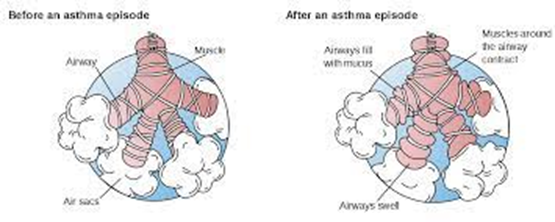A nurse is discussing factors that can lead to obstructive sleep apnea with a group of older adults. Which of the following factors should the nurse include in the teaching? Select all that apply.Loss
Loss of teeth
Stroke
Sleepiness
Fatty deposits
Muscle dysfunction
Correct Answer : B,D,E
Choice A Reason:
Loss of teeth is not typically considered a direct factor contributing to obstructive sleep apnea. While the presence of teeth may play a role in maintaining the structure of the oral cavity, it is not a primary risk factor for OSA.
Choice B Reason:
Stroke is correct. Individuals who have had a stroke are at increased risk of developing obstructive sleep apnea. Stroke can cause damage to areas of the brain involved in controlling breathing and upper airway function, leading to disruptions in respiratory control during sleep.
Choice C Reason:
Sleepiness is a symptom commonly associated with obstructive sleep apnea rather than a direct contributing factor. Excessive daytime sleepiness is a consequence of disrupted sleep patterns and recurrent episodes of breathing cessation during the night, which are characteristic features of obstructive sleep apnea.
Choice D Reason:
Fatty deposits is correct. Excessive fatty deposits, particularly around the neck and throat, can contribute to the narrowing and collapse of the upper airway during sleep, increasing the risk of obstructive sleep apnea. Obesity is a significant risk factor for OSA due to the accumulation of fat deposits in the upper airway tissues.
Choice E Reason:
Muscle dysfunction is correct. Muscle dysfunction, particularly of the muscles surrounding the upper airway, can impair the ability of these muscles to keep the airway open during sleep. Weakness or dysfunction of these muscles can lead to increased collapsibility of the upper airway, contributing to obstructive sleep apnea.
Nursing Test Bank
Naxlex Comprehensive Predictor Exams
Related Questions
Correct Answer is C
Explanation
Choice A Reason:
Decreased mucus production contributes to airway constriction: This statement is incorrect. Bronchospasm does not decrease mucus production; instead, it primarily affects the smooth muscles surrounding the bronchioles, leading to their constriction and narrowing of the airways. Increased mucus production, often accompanied by inflammation, can contribute to airway obstruction in conditions like asthma.
Choice B Reason:
Inflammation is reduced due to airway diameter: This statement is incorrect. Bronchospasm typically occurs in the setting of inflammation in conditions such as asthma. Constriction of the airways during bronchospasm exacerbates the inflammation and can further narrow the airways, leading to symptoms such as wheezing and dyspnea.
Choice C Reason:
Bronchospasm occurs when there is inflammation, edema, and excess mucus: This statement is partially correct. Bronchospasm often occurs in the presence of inflammation, edema, and excess mucus production, as seen in conditions like asthma. These factors contribute to airway hyperresponsiveness, leading to bronchospasm and airway narrowing.
Choice D Reason:
Airway obstruction occurs due to thinning mucus: This statement is incorrect. Airway obstruction in conditions like asthma is primarily due to bronchospasm, inflammation, and excessive mucus production, rather than thinning mucus. Thinning of mucus would not typically contribute to airway obstruction.

Correct Answer is B
Explanation
Choice A Reason:
"Do panting breaths several times a day." This statement is inappropriate. Panting breaths involve rapid, shallow breathing similar to what a dog does when it's hot. This technique may not be as effective in clearing mucus or promoting lung expansion compared to deep coughing. While panting breaths may have some benefits in promoting ventilation and increasing lung volume, they may not be as targeted or efficient in preventing atelectasis as other techniques such as deep coughing
Choice B Reason:
"Perform deep coughing twice a day." This statement is correct. Deep coughing helps clear mucus and secretions from the airways, reducing the risk of blockages that can lead to atelectasis. It promotes airway clearance and lung expansion, maintaining respiratory function. Regular deep coughing is particularly important for individuals with spinal cord injuries, as they may have impaired cough reflexes or weakened respiratory muscles, increasing their vulnerability to atelectasis.
Choice C Reason:
"Strengthen your chest muscles by performing therapy exercises." This statement is incorrect. While strengthening chest muscles through therapy exercises can be beneficial for overall respiratory health, it may not directly target the prevention of atelectasis. Atelectasis is primarily caused by the collapse of lung tissue due to mucus buildup or reduced lung expansion, rather than weakness of chest muscles. While therapy exercises may have other benefits such as improving respiratory function and endurance, they may not be the most effective strategy for preventing atelectasis in individuals with spinal cord injuries.
Choice D Reason:
"Get plenty of rest throughout the day." This statement is incorrect. Rest is important for overall health and well-being, but it may not directly contribute to the prevention of atelectasis. Inactivity and prolonged bed rest can actually increase the risk of atelectasis by reducing lung expansion and promoting mucus accumulation in the airways. While adequate rest is necessary for recovery and energy conservation, it should be balanced with activities that promote lung expansion and airway clearance, such as deep breathing exercises and mobility.
Whether you are a student looking to ace your exams or a practicing nurse seeking to enhance your expertise , our nursing education contents will empower you with the confidence and competence to make a difference in the lives of patients and become a respected leader in the healthcare field.
Visit Naxlex, invest in your future and unlock endless possibilities with our unparalleled nursing education contents today
Report Wrong Answer on the Current Question
Do you disagree with the answer? If yes, what is your expected answer? Explain.
Kindly be descriptive with the issue you are facing.
